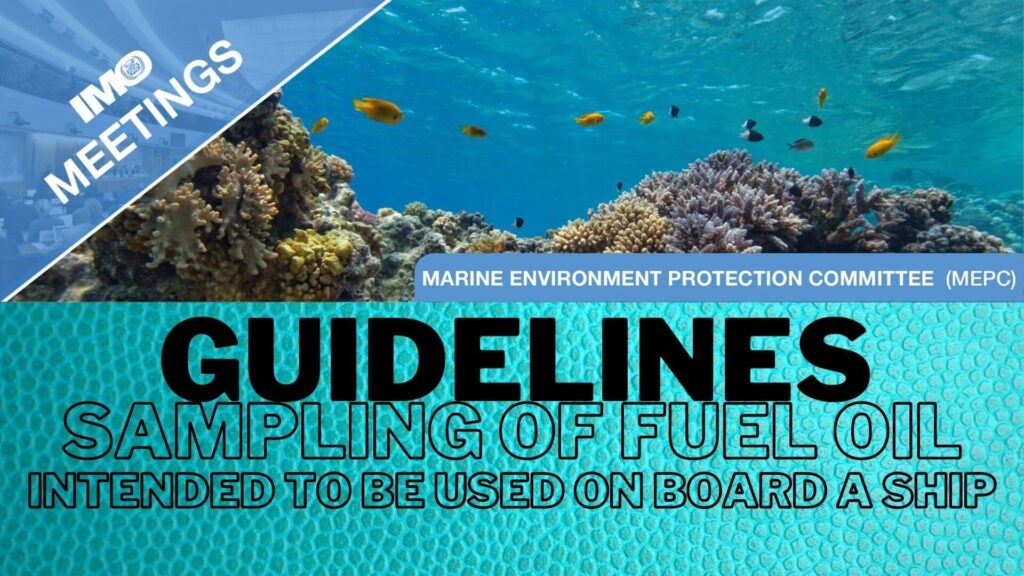
(www.MaritimeCyprus.com) The IMO Marine Environment Protection Committee (MEPC), at its seventy-fifth session (16 to 20 November 2020), has approved the 2020 Guidelines for onboard sampling of fuel oil intended to be used or carried for use onboard a ship.
The objective of the Guidelines is to establish an agreed method for the sampling, from tanks, of liquid fuel oil, intended to be used or carried for use onboard a ship and thereby promoting the effective control and enforcement of the relevant provisions of MARPOL Annex VI.
Fuel oil sampling should be performed in a manner that ensures the safety of personnel and of the ship. Fuel oil sampling in accordance with the Guidelines should be undertaken expeditiously and should not cause undue delay to the ship.
Sampling procedures:
Tank sampling involves obtaining a sample of fuel oil from the tank in question. The sample obtained is representative of the fuel oil at the location from where it was drawn. Fuel oil in a tank may be sampled by use of the ship’s fuel oil transfer system or, in some instances, directly from the tank. Alternative sampling approaches may be used provided they deliver a fuel oil sample that is representative of the fuel oil at the location from where the sample was drawn.
The exact arrangements in each case should be agreed in advance with the ship’s representative. In all instances, attention should be given to avoiding sample contamination by extraneous or sedimented matter.
1. Sampling by use of the ship’s fuel oil transfer system:
When sampling by use of the ship’s fuel oil transfer system it should preferably be set up to recirculate to the tank from which it is drawing. In instances where that is not possible, close attention should be given to not over-filling the receiving tank or mixing fuel oils from different consignments. It should be noted that for a viscous fuel oil to be in a pumpable condition it will typically need to be at a temperature corresponding to a viscosity of around 800 – 1,000 cSt.
Sampling should be undertaken downstream of the pump using a suitable sampling connection drawing from the flowing fuel oil. That sampling connection should fulfill all the following conditions:
- it should be easily and safely accessible;
- the sampling connection point should be in a position shielded from heated surfaces or electrical equipment, and any necessary shielding device or construction should be sturdy enough to ensure that any leaks, splashes or spray, under transfer pump discharge pressure, do not impinge onto such surfaces or equipment; and
- the sampling connection should be provided with suitable spill collection arrangements or drainage to the drain tank or other safe location.
Having established that the fuel oil transfer system is handling the fuel oil to be sampled, the sampling connection should be thoroughly flushed through and thereafter the required sample should be obtained.
2. Direct sampling from a tank:
System tanks, such as settling or service tanks, should preferably be sampled using the 2019 Guidelines for onboard sampling for the verification of the sulphur content of the fuel oil used onboard ships. To be noted that viscous fuel oils in such tanks will be at elevated temperatures and hence due caution would be necessary. Such tanks may be sampled directly only by means of tapping points mounted on the tank which should meet the requirements given above. Sampling from a system tank should not be undertaken by means of removing an access plate or from the test drain connection.
Loaded cargo or other ship operational factors may preclude direct sampling from a tank.
Where direct tank sampling is to be undertaken, via – for example – a suitable access plate or tank hatch, it should be understood that the ship itself may not carry the necessary sampling equipment. In order to take a fuel oil sample direct from a tank, consideration should be given to the use of a specialist service provider having the appropriate sampling equipment, such as that given in ISO 3170:2004, and the expertise necessary to obtain the required sample in a safe and competent manner.
Since a sample obtained is representative of the fuel oil at the level or point from where it was drawn, it will therefore not always be necessary to take samples from more than one level or point in a tank.
Sampling may alternatively be undertaken from the sounding pipe of a tank by means of a suitable sampling arrangement. When sampling from a sounding pipe, the design of that sounding pipe and the recent filling history of that tank should be considered to assess the relationship of the fuel oil in the sounding pipe to that in the associated tank.
Sample handling:
The sample obtained should be collected into a suitable sample bottle. The sample bottle should be sealed by the inspector with a unique means of identification installed in the presence of the ship’s representative. The ship should be given the option of retaining a duplicate sample. The label should include the following information:
- sampling point location where the sample was drawn;
- bunker delivery note details of the fuel oil sampled, as per information required by appendix V of MARPOL Annex VI;
- date and port of sampling;
- name and IMO number of the ship;
- details of seal identification; and
- signatures and names of the inspector and the ship’s representative.
Click below to download the relevant IMO circular:
Source: IMO














